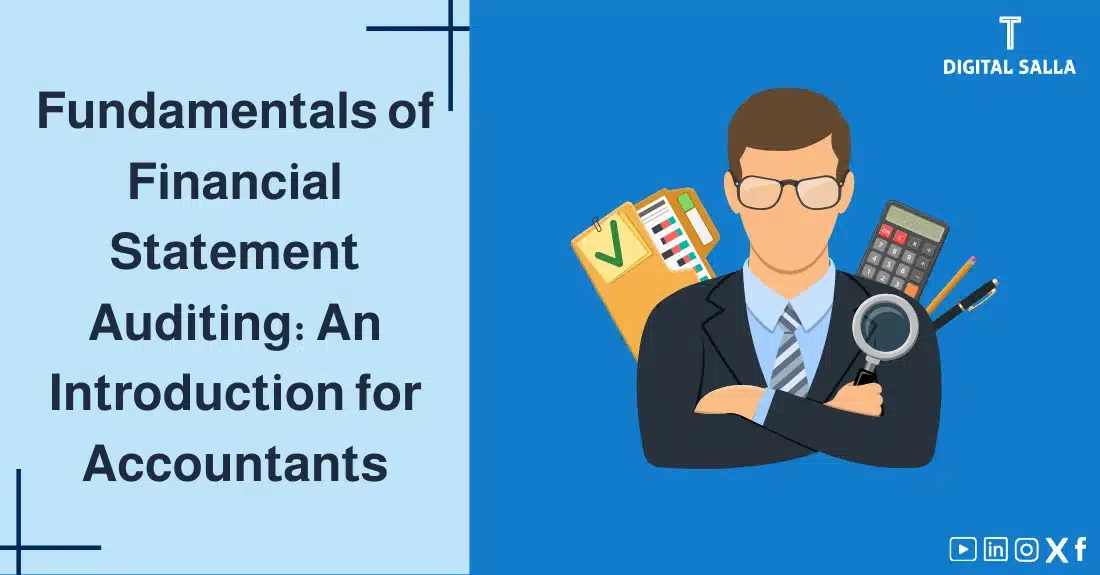Fundamentals of Financial Statement Auditing: An Introduction for Accountants

A Financial Statement Audit is a vital process aimed at verifying the accuracy and fairness of the financial information presented by an entity. A Financial Statement Audit is an essential tool for enhancing confidence in financial statements and providing stakeholders with an independent and objective assessment of the entity’s financial performance and position. In this article, we will provide an introduction to the basics of a Financial Statement Audit, discussing the concept of auditing, its objectives and types, focusing on the stages of the audit process, the auditor’s responsibilities, and the importance of auditing financial statements in enhancing the credibility of financial reports.
What is a Financial Statement Audit?
A Financial Statement Audit is an independent and objective examination of an entity’s financial statements, with the objective of expressing a professional opinion on whether these statements fairly present the entity’s financial position, results of operations, and cash flows in accordance with specified accounting standards, such as International Financial Reporting Standards (IFRS) or Generally Accepted Accounting Principles (GAAP).
Objectives of a Financial Statement Audit:
- Expressing an Opinion on the Fairness of the Financial Statements: The primary objective of a Financial Statement Audit is for the auditor to express a professional opinion on whether the financial statements fairly present, in all material respects, the entity’s financial position, results of operations, and cash flows in accordance with the applicable accounting standards.
- Enhancing Confidence in Financial Statements: A Financial Statement Audit contributes to enhancing the confidence of investors, creditors, and other stakeholders in the financial information presented by the entity.
- Detecting Errors and Fraud: A Financial Statement Audit helps in detecting errors or fraud in the accounting records, reducing the risk of material misstatements in the financial statements.
- Improving the Quality of Financial Information: A Financial Statement Audit leads to improved quality and reliability of the financial information provided to stakeholders.
- Providing Recommendations to Improve Internal Controls: The auditor may provide recommendations to management to improve the entity’s internal control systems.
Types of Audits:
Financial Statement Audits can be classified into two main types:
- External Audit:
- Performed by an independent external auditor who is not affiliated with the entity. The auditor must be professionally qualified and licensed to practice auditing.
- Aims to provide an unbiased professional opinion on the fairness of the entity’s financial statements.
- The external auditor is typically appointed by the entity’s shareholders or board of directors.
- The external auditor issues a report expressing their opinion on the financial statements.
- Internal Audit:
- Performed by internal auditors who are employees of the entity.
- Aims to evaluate the effectiveness of the entity’s internal control and risk management systems.
- The internal auditor reports to senior management or the audit committee.
- Internal auditing helps improve the efficiency and effectiveness of the entity’s operations.
Stages of a Financial Statement Audit:
A Financial Statement Audit typically involves several key stages:
- Audit Planning:
- Understanding the Entity and its Environment: The auditor must understand the nature of the entity’s business, the environment in which it operates, its objectives and strategies, and its internal control system.
- Determining the Audit Scope: Defining the audit objectives, the financial statements to be audited, and the period covered by the audit.
- Risk Assessment: Identifying and assessing the risks of material misstatement in the financial statements, whether due to error or fraud.
- Determining Materiality: Determining the materiality level, which is the threshold at which errors or misstatements in the financial statements could influence users’ decisions.
- Preparing the Audit Program: Developing a detailed plan for the audit procedures to be performed.
- Performing Audit Procedures:
- Collecting Audit Evidence: The auditor gathers sufficient and appropriate audit evidence to support their opinion on the financial statements.
- Tests of Controls: Aim to evaluate the effectiveness of the entity’s internal control systems.
- Substantive Procedures: Aim to detect material misstatements in the financial statements. These include:
- Analytical Procedures: Comparing financial data with other relevant data, such as prior period data or industry averages.
- Tests of Details: Examining a sample of transactions and balances to verify their accuracy and completeness.
- Evaluating Audit Results:
- Evaluating Audit Evidence: The auditor evaluates the audit evidence gathered to determine whether it is sufficient and appropriate to support their opinion on the financial statements.
- Identifying Misstatements: The auditor identifies any misstatements discovered during the audit and assesses whether they are material.
- Communicating with Management: The auditor discusses the audit findings with management and requests them to correct any material misstatements.
- Issuing the Audit Report:
- The auditor issues a report expressing their opinion on the fairness of the financial statements in accordance with the applicable accounting standards.
- Types of Audit Opinions:
- Unqualified Opinion: Issued when the financial statements are free from material misstatement and present fairly, in all material respects, the entity’s financial position, results of operations, and cash flows.
- Qualified Opinion: Issued when the financial statements are free from material misstatement, except for a specific item or items.
- Adverse Opinion: Issued when the financial statements contain pervasive material misstatements, such that they cannot be considered fair or reliable.
- Disclaimer of Opinion: Issued when the auditor is unable to obtain sufficient appropriate audit evidence to form an opinion on the financial statements.
Auditor’s Responsibilities:
- Obtain a sufficient understanding of the entity, its environment, and its internal control system to assess the risks of material misstatement.
- Design and perform audit procedures appropriate to address the assessed risks.
- Obtain sufficient appropriate audit evidence to support their opinion on the financial statements.
- Evaluate the adequacy and appropriateness of the disclosures in the financial statements.
- Express an independent and objective professional opinion on the fairness of the financial statements in the audit report.
- Comply with ethical codes of conduct and generally accepted auditing standards.
- Maintain the confidentiality of information obtained during the audit process.
Importance of a Financial Statement Audit:
A Financial Statement Audit is an essential process for enhancing confidence in the financial information presented by entities, for the following reasons:
- Protecting the Interests of Investors and Creditors: Auditing helps protect the interests of investors and creditors by ensuring that the financial statements are free from material misstatement.
- Enhancing Transparency and Accountability: Auditing contributes to enhancing transparency and accountability by providing an independent and objective assessment of the financial statements.
- Improving the Quality of Financial Reporting: Auditing leads to improved quality and reliability of the financial information provided to stakeholders.
- Supporting the Efficiency of Capital Markets: Auditing contributes to supporting the efficiency of capital markets by providing high-quality financial information that helps investors make sound investment decisions.
- Preventing Fraud and Embezzlement: Auditing helps detect and prevent fraud and embezzlement by examining financial records and evaluating internal control systems.
Role of Technology in a Financial Statement Audit:
Technology significantly impacts the Financial Statement Audit process, as it provides specialized tools and software that help auditors to:
- Analyze large amounts of financial data more efficiently and effectively.
- Use data analytics tools to detect unusual patterns and trends.
- Automate some routine audit procedures.
- Improve the quality and efficiency of the audit process.
- Focus on areas of higher risk.
Challenges Facing the Financial Statement Audit Process:
- Complexity of Accounting Standards: IFRS are complex, which can make them difficult to understand and apply correctly.
- Need for Professional Judgment: Auditing financial statements requires the use of professional judgment in many situations, which can lead to differences in judgment between auditors.
- Limited Scope of the Audit: The auditor cannot examine all transactions and balances, so there is always a possibility that errors or misstatements may go undetected.
- Technological Developments: Auditors must keep pace with rapidly changing technological developments and their impact on financial statements and the audit process.
- Stakeholder Expectations: Stakeholders expect auditors to provide more assurances about financial statements, including assurances about the effectiveness of internal controls and the ability to continue as a going concern.
The Difference Between Internal Auditing and External Auditing:
| Feature | Internal Auditing | External Auditing |
|---|---|---|
| Performing Party | Internal auditors who are employees of the entity. | An independent external auditor who is not affiliated with the entity. |
| Objective | Evaluate the effectiveness of internal control and risk management systems. | Express an opinion on the fairness of the financial statements. |
| Reports | Reports are submitted to senior management and the audit committee. | The auditor issues a report addressed to the entity’s shareholders. |
| Scope | Determined by management. | Determined in accordance with generally accepted auditing standards. |
| Independence | Less independent than the external auditor. | More independent. |
Conclusion:
A Financial Statement Audit is an important process for ensuring the reliability and fairness of the financial information presented by entities. Auditors must comply with generally accepted auditing standards and ethical codes of conduct to provide high-quality audit services that enhance confidence in financial statements. Understanding the basics of a Financial Statement Audit is essential for accountants, auditors, investors, and anyone seeking to understand how to assess the quality and reliability of financial information. With ongoing developments in the business environment, auditors must keep pace with these developments and adapt their methods and procedures to ensure the effectiveness of the audit process.
Finally, technology offers significant opportunities to improve the efficiency and effectiveness of auditing Financial Statements, and auditors must take advantage of these opportunities to provide value-added services to their clients.
